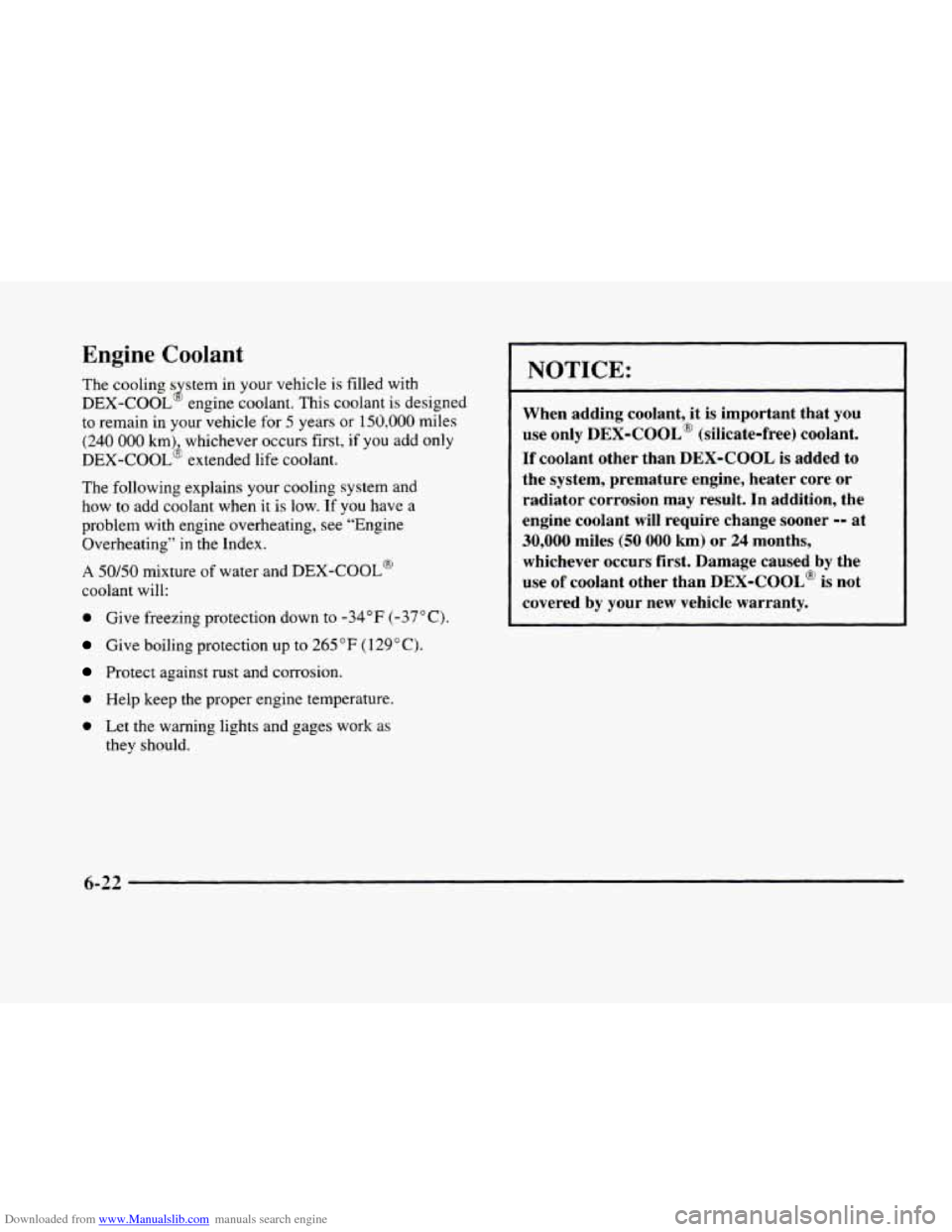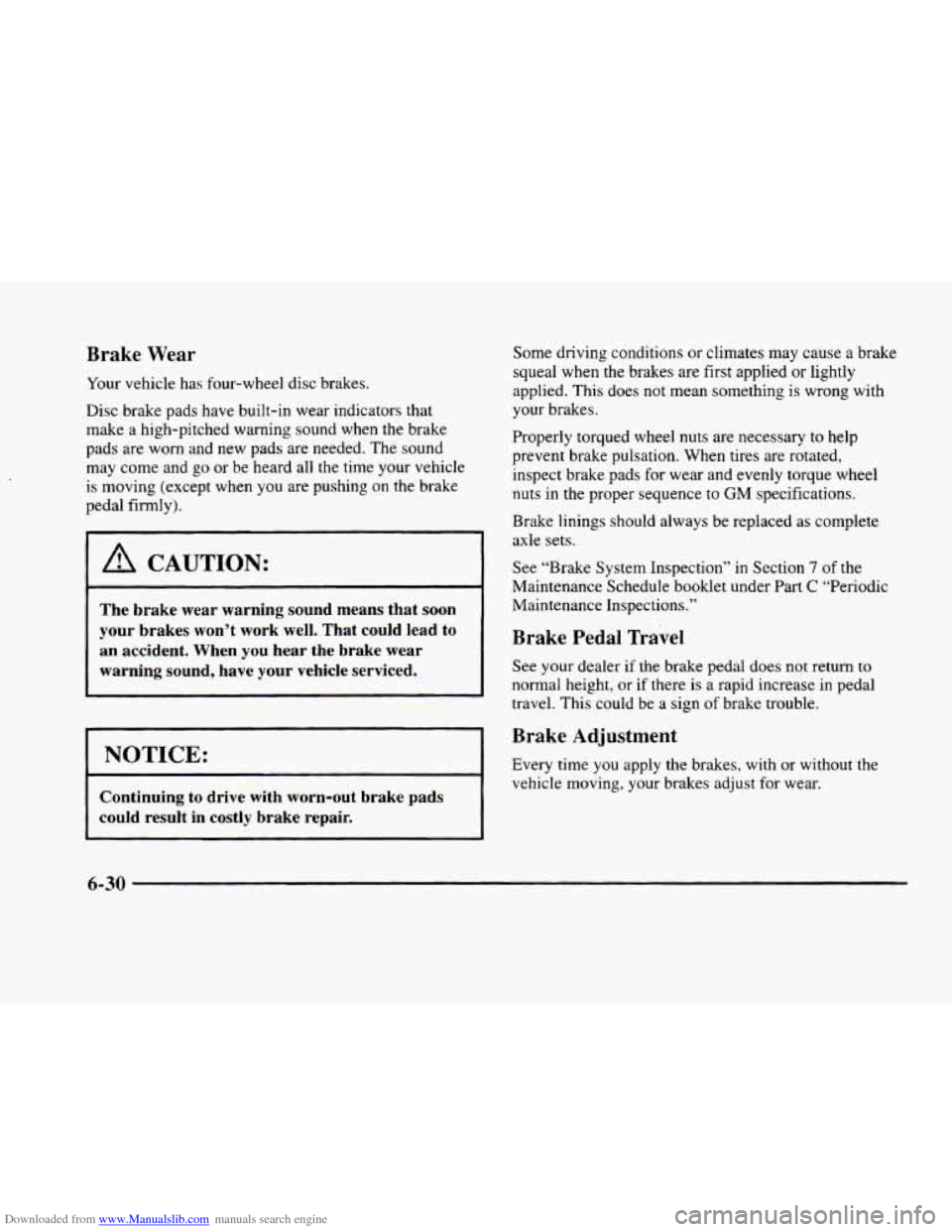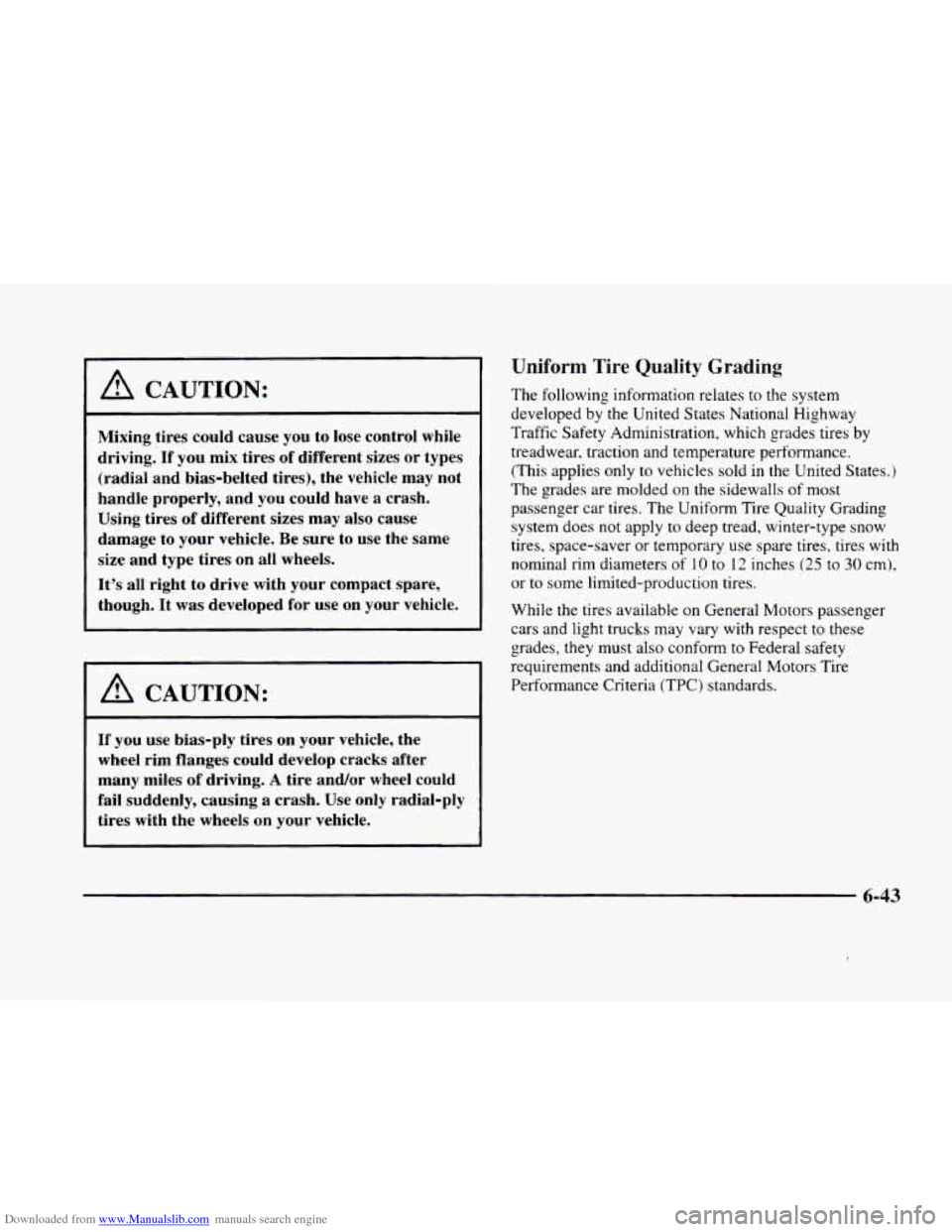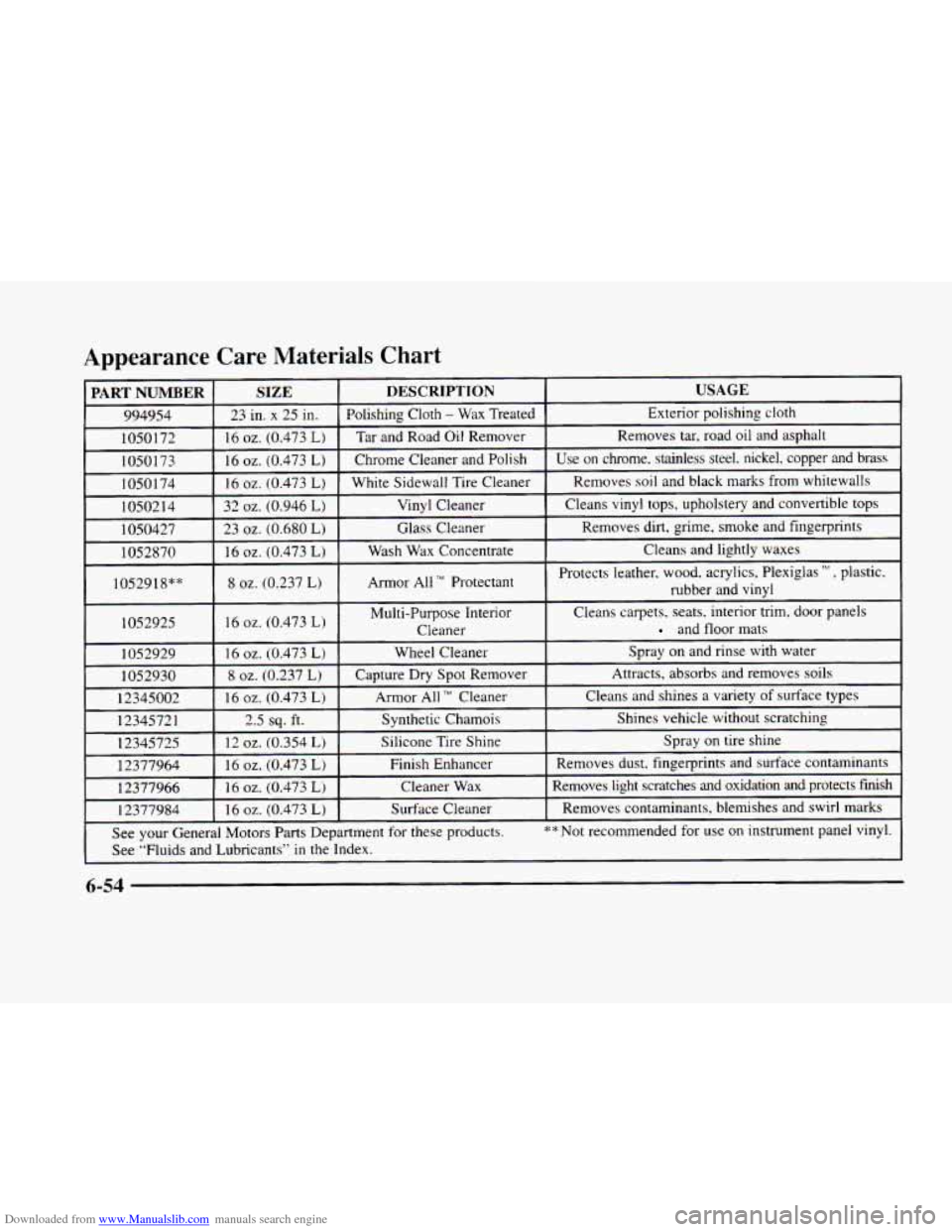1998 CADILLAC ELDORADO light
[x] Cancel search: lightPage 302 of 380

Downloaded from www.Manualslib.com manuals search engine Engine Coolant
The cooling s stem in your vehicle is filled with
DEX-COOL engine coolant. This coolant is designed
to remain in your vehicle for
5 years or 150,000 miles
(240 000 km) whichever occurs first, if you add only
DEX-COOL’ extended life coolant.
J
The following explains your cooling system and
how
to add coolant when it is low. If you have a
problem with engine overheating, see “Engine
Overheating” in the Index.
A 50/50 mixture of water and DEX-COOL@
coolant will:
0 Give freezing protection down to -34°F (-37°C).
Give boiling protection up to 265 “F (1 29°C).
Protect against rust and corrosion.
0 Help keep the proper engine temperature.
0 Let the warning lights and gages work as
they should.
NOTICE:
When adding coolant, it is important that you
use only
DEX-COOL@ (silicate-free) coolant.
If coolant other than DEX-COOL is added to
the system, premature engine, heater core or radiator corrosion may result. In addition, the
engine coolant will require change sooner
-0 at
30,000 miles (50 000 km) or 24 months,
whichever occurs first. Damage caused by the
use
of coolant other than DEX-COOL@ is not
covered by your new vehicle warranty.
6-32
Page 304 of 380

Downloaded from www.Manualslib.com manuals search engine Checking Coolant
.
The surge tank is located next to the engine block on the
passenger's side
of the engine.
The cooling system is under a
lot of pressure when it
is hot. If the CHECK COOLANT LEVEL message
appears
on the Driver Information Center (DIC), you
will need to add coolant.
A CAUTION:
Turning the surge tank pressure cap when the
engine and radiator are hot can allow steam and
scalding liquids to blow out and burn
you badly.
Never turn the surge tank pressure cap
-- even a
little
-- when the engine and radiator are hot.
When your engine is cold. the coolant level should be at
the full cold mark, which
is 2.5 inches (6.4 cm) below
the base
of the fill neck. Use a flashlight as necessary to
see into the tank.
.................................................. ................. ...... ....... ............ ...... ............ ............ .......... ...................... ....... .................. ..... ..................................... .....................
If the CHECK COOLANT LEVEL message comes on.
it means you're low on engine coolant.
For more information, see "Check Coolant Level"
message in the Index.
6-24
Page 308 of 380

Downloaded from www.Manualslib.com manuals search engine Brakes
Brake Fluid
Your brake master cylinder reservoir is here. It is filled
with
DOT-3 brake fluid.
There are only two reasons why the brake fluid level in
the
reservoir might go down. The first is that the brake fluid
goes down to
an acceptable level during normal brake
lining wear. When new
linings are put in, the fluid level
goes back
up. The other reason is that fluid is leaking out
of the brake system. If it is. you should have your brake
system fixed, since a leak means that sooner or later your
brakes won’t work well, or won’t work at all.
So, it isn’t a good idea to “top off’ your brake fluid.
Adding brake fluid won’t correct a leak. If you add fluid
when your linings are
worn, then you’ll have too much
fluid when you get new brake linings.
You should add
(or remove) brake fluid, as necessary, only when work
is done on the brake hydraulic system.
I A CAUTION:
If you have too much brake fluid, it can spill
on the engine.
The fluid will burn if the engine
is hot enough. You or others could be burned,
and your vehicle could be damaged. Add brake
fluid only when work
is done on the brake
hydraulic system.
When your brake fluid falls to a low level, your brake
warning light will come
on. See “Brake System Warning
Light”
in the Index.
6-28
Page 310 of 380

Downloaded from www.Manualslib.com manuals search engine Brake Wear
Your vehicle has four-wheel disc brakes.
Disc brake pads have built-in wear indicators that
make a high-pitched warning sound when the brake
pads are worn and new pads are needed. The sound
may come and go or be heard all the time your vehicle
is moving (except when you are pushing on the brake
pedal firmly).
I A CAUTION:
The brake wear warning sound means that soon
your brakes won’t work well. That could lead to
an accident, When you hear the brake wear
warning sound, have your vehicle serviced.
NOTICE:
Continuing to drive with worn-out brake pads
could result
in costly brake repair.
Some driving conditions or climates may cause a brake
squeal when the brakes
are first applied or lightly
applied. This does not mean something is wrong with
your brakes.
Properly torqued wheel nuts are necessary
to help
prevent brake pulsation. When tires are rotated,
inspect brake pads for wear and evenly torque wheel
nuts
in the proper sequence to GM specifications.
Brake linings should always be replaced as complete
axle sets.
See “Brake System Inspection”
in Section 7 of the
Maintenance Schedule booklet under Part
C “Periodic
Maintenance Inspections.”
Brake Pedal Travel
See your dealer if the brake pedal does not return to
normal height, or if there is a rapid increase in pedal
travel. This could be a sign of brake trouble.
Brake Adjustment
Every time you apply the brakes, with or without the
vehicle moving, your brakes adjust for wear.
6-30
Page 323 of 380

Downloaded from www.Manualslib.com manuals search engine I A CAUTION:
Mixing tires could cause you to lose control while
driving.
If you mix tires of different sizes or types
(radial and bias-belted tires), the vehicle may not
handle properly, and you could have a crash.
Using tires of different sizes may also cause
damage to
your vehicle. Be sure to use the same
size and type tires on
all wheels.
It’s all right to drive with your compact spare,
though. It
was developed for use on your vehicle.
A CAUTION:
If you use bias-ply tires on your vehicle, the
wheel rim flanges could develop cracks after
many miles of driving.
A tire and/or wheel could
fail suddenly, causing
a crash. Use only radial-ply
tires with the wheels
on your vehicle.
Uniform Tire Quality Grading
The following information relates to the system
developed by the United States National Highway
Traffic Safety Administration, which grades tires by
treadwear. traction and temperature performance.
(This applies only to vehicles sold in the United States.)
The grades are molded
on the sidewalls of most
passenger car tires. The Uniform Tire Quality Grading
system does
not apply to deep tread, winter-type snow
tires, space-saver or temporary
use spare tires, tires with
nominal rim diameters of
10 to 12 inches (25 to 30 cm),
or
to some limited-production tires.
While the tires available on General Motors passenger
cars and light trucks may vary with respect to these
grades, they must also conform to Federal safety
requirements and additional General Motors Tire
Performance Criteria (TPC) standards.
6-43
Page 334 of 380

Downloaded from www.Manualslib.com manuals search engine Appearance Care Materials Chart
I PART NUMBER I SIZE I DESCRIPTION I USAGE I
994954 23 in. x 25 in. Polishing Cloth - Wax
Treated
Exterior polishing cloth
1050172 16
oz. (0.473 L) Tar and Road Oil Remover Removes tar, road oil and asphalt
1050173 16
oz. (0.473 L) Chrome Cleaner and Polish Use on chrome.
stainless steel. nickel, copper and brass
1050 174 16 oz. (,0.473 L) White Sidewall Tire Cleaner Removes soil and
black marks from whitewalls
10502 14 32
oz. (0.946 L) Vinyl Cleaner Cleans vinyl tops,
upholstery and convertible tops
1050427 23
oz. (0.680 L) Glass Cleaner Removes dirt,
grime, smoke and fingerprints
1052870 16
oz. (0.473 L) Wash Wax Concentrate Cleans
and lightly waxes
1052918""
8 02. (0.237 L) Armor All TM Protectant Protects leather.
wood. acrylics, Plexiglas lh1 , plastic.
rubber and vinyl
1052925 16
oz. (0.473 L) Multi-Purpose Interior Cleans carpets. seats, interior trim, door panels
Cleaner
and floor mats
6-54
Page 337 of 380

Downloaded from www.Manualslib.com manuals search engine Fuse
BODY 1
BODY 2
BODY 3
Usage
Road Sensing Suspension (RSS) Fuse
(ETC Only), Convenience Fuse, BATT
Fuse, Antenna Fuse, Passenger and
Driver Seat Belt Comfort Solenoids,
Trunk and Fuel Door Release
Solenoids and Relays, Door
Lock/Unlock Relays, Damper Relay
(ETC Only), Parking Lamp Relay,
Right and Left Park Fuse, Rear Fog
Lamp Relay (Export)
Defog Relay, Pull-Down Fuse, Right
and
Left Heated Seat Fuse, Electronic
Level Control (ELC) Fusemelay,
Antenna Fuse, Heated Mirror Fuse,
Heated Backlite Fuse, Electronic Level,
Control Breaker
Controlled Power Relay, Controlled
Power Back-up Relay, Cluster
Fuse,
Platform Zone Module (PZM) Fuse,
Radio Fuse,
DAB Relay, Trunk and
Fuel Door Release Relay, High-Beam
Relay, Comfort Fuse, AMP (Bose
Only) Fuse, Right and Left Bose Relay
Fuse Usage
INADVERT Inadvertent Power Relay, Interior
Lamps Fuse, Cigarette Lighter-
1 Fuse,
Courtesy Lamp Relay
LAMPS
IGN 1
Headlamps Fusemelay, High/Low
Beam Control Relay, Fog Lamp
Fuse,
DlU Fuse, Hazard Fuse, Mirror Fuse,
Inadvertent Power Relay, Right and
Left High-Beam Fuse, Right and Left
Low-Beam
Fuse, Stop Fuse, Fog Lamp
Relay, DRL Relay
Rear Ignition-
1 Relay, Wiper Fuse,
Relay Ignition-
1 Fuse, Supplemental
Inflatable Restraint (SIR) Fuse, Accessory Relay
WINDOWS Delayed Accessory Bus (DAB) Relay
SEATS
BATT
3
BATT 2
Horn Relay, Driver and Passenger
Lumbar IdOut Relays, Driver and
Passenger Up/Down Relays
Steering Column Ignition Switch
Steering Column Ignition Switch
6-57
Page 338 of 380

Downloaded from www.Manualslib.com manuals search engine Fuse
IGN 1”
BATT 1
BRAKES
Usage
Front and Rear Ignition- 1 Relay,
Oxygen Sensor
1 and 2 Fuse, Fuel
Fuse, Cruise Fuse,
DFU Relay, Front
and Rear Fog Lamp Relay, Control
Power Back-up Relay, Ignition-
1 Fuse,
Fuel Pump Relay
Starter Relay and Solenoid, ParldXev
Fuse, Park Relay, PCM Fuse, AC
Compressor Fuse and Relay,
Fan
Relays, Reverse Relay
ABS Brake Modulator
COOL
FNS Cooling Fan Relays 1 and 3
* Do not alter OBD I1 related fuses or circuit breakers.
Fuses and Circuit Breakers
The wiring circuits in your vehicle are protected from
short circuits by a combination
of fuses and circuit
breakers.
This greatly reduces the chance of fires
caused by electrical problems.
Look at the silver-colored band inside the fuse. If the
band is broken or melted, replace the fuse. Be sure you
replace a bad fuse with
a new one of the identical size
and rating.
If you ever have a problem on the road and don’t have
a spare fuse, you can “borrow” one that has the same
amperage. Pick some feature of your vehicle that
you can get along without
-- like the radio or
cigarette lighter -- and use its fuse, if it is the correct
amperage. Replace it as soon as you can.
There
are two fuse blocks in your vehicle: the engine
compartment fuse block and the rear compartment
fuse block.
6-58